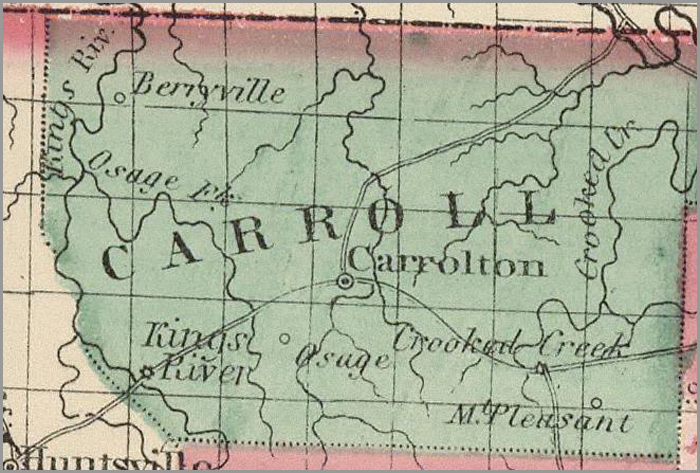Carroll County, Arkansas

- Formed: November 1, 1833
- County Population 1860: 9,053
- Slave Population 1860: 330
- Civil War Engagements
– Skirmish at Carrollton, January 10, 1863
– Skirmish at Crooked Creek, February 5, 1864
– Suffered constant guerrilla warfare
Image courtesy of the David Rumsey Historical Map Collection
Before white settlement, Carroll County, Arkansas was traditionally Osage territory. In the 1800s, the Osage shared the area with the Cherokee and Choctaws who were pushed into the area from the Southeastern United States. White settlement began in earnest in the 1830s, most coming from the mountains in Tennessee and Kentucky. Early settlers included William and Charles Sneed and Louis Russell, William Coker, David Williams, Martin, John, and Samuel Standridge, Jerry and Jacob Meeks, Squire and Richard Blevins, George Stone, and Robert Dawson.
Carroll County is located on the Missouri-Arkansas border in the Northwestern part of the state. Fresh water sources are plentiful and include King’s River, Dry Creek, Indian Creek, White River, Osage Creek, Long Creek, and Yocum Creek. Prairies, including Big Prairie and Scott’s Prairie, provide abundant grazing land for livestock. The area contains natural silver and iron deposits, and the soil is suitable for growing wheat and corn.
Carroll County was officially established on November 1, 1833. It was named after Charles Carroll, of Carrollton Tennessee, who was among those who signed the Declaration of Independence. Burnnett Cheatham and John S. Blair were in charge of naming the county seat and established it at Carrollton. There were several prominent citizens during the county’s early years. Henderson Lafferty helped Carrollton’s development. Squire Wilson Ashbury built the first ferry across the White River, a quarry to supply building stone to Carroll and surrounding counties, and built Beaver Inn (later renamed Riverside Inn). Blackburn Henderson Berry settled in present day Berryville, which was the county’s second county seat. Arthur A. Baker became the first doctor in the county and donated land for the first public school. Jacob Meek helped save several important documents from destruction during the Civil War and later became Berryville’s mayor. Tilford Denton became court clerk, county treasurer, and fought in the Civil War as a Captain-Quartermaster in the Carroll County Militia. He also donated land for the public school. James Fancher served in the Arkansas House of Representatives.
When the Civil War began, most Carroll County residents sided with the Confederacy and voted for secession. Slavery was not a huge issue in Carroll County, but most residents could not fathom going to war with other Southern states. The Carroll County Home Guard formed shortly after Arkansas seceded, and formed four companies under H.B. Fletcher, J.H. Pittman, John Denney, and Leander Hayhurst respectively. These companies took part in the Battle of Wilson’s Creek in Greene County, Missouri. Carroll County men also took part in several other regiments. These included: Company E, 16th Arkansas Mounted Infantry under Captain W.S. Poynor, Company D, 16th Arkansas Mounted Infantry, and Companies K and G, First Regiment Arkansas Volunteer Cavalry under Captain Rowan E.M. Mack and Captain Theodore Youngblood respectively. These regiments took part in the Battle of Pea Ridge in Benton County in March, 1862.
There were many Carroll County residents who refused to take part in the war at all, for either army. They formed the Arkansas Peace Society, sometimes called the Peace Organization Society, which advocated resistance to either army in Carroll and other Arkansas Counties. Several members of this society were arrested in 1861, and the organization disbanded. Several years after the war ended a fierce political debate erupted as the location for the new county seat. The issue was resolved through an election in which Berryville was declared the county seat in 1875. A courthouse was constructed in 1880. A newspaper, the Carroll County Bowlder, was the first printed in the county. It was printed in Carrollton in late 1874 and later moved to Berryville. Carrollton High School, Fairview Academy, and Clarke’s Academy provided education to the citizens living in Carroll County. The use of mineral springs in the western part of the county in 1879 brought a rapid population increase in the area. Individuals seeking the healing powers of its waters made Eureka Springs a thriving community.
 Browse all collections in Carroll County
Browse all collections in Carroll County
- Consulted:
- Jim Lairr, An Outlander’s History of Carroll County, Arkansas, 1830-1983 (Berryville, AR: Carroll County Historical and Genealogical Society, 1983).
- “Carroll County”, The Encyclopedia of Arkansas History and Culture, (Little Rock, AR: Central Arkansas Library System), accessed on 3 November 2010,
- http://encyclopediaofarkansas.net/encyclopedia/entry-detail.aspx?entryID=752
- “Clarke’s Academy”, The Encyclopedia of Arkansas History and Culture, (Little Rock, AR: Central Arkansas Library System), accessed on 23 January 2012,
- http://encyclopediaofarkansas.net/encyclopedia/entry-detail.aspx?entryID=5616












